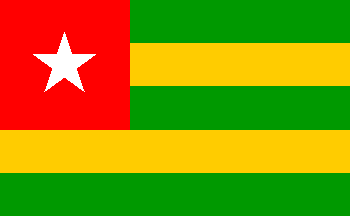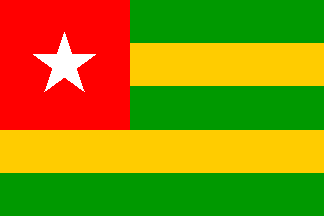 1:1.618
image by Željko Heimer, 21 May 2000
1:1.618
image by Željko Heimer, 21 May 2000

Last modified: 2025-09-13 by bruce berry
Keywords: togo | africa | germany | france | britain | ghana | gold coast | star | stripes | pan-african |
Links: FOTW homepage |
search |
disclaimer and copyright |
write us |
mirrors

![[National flag and ensign]](../misc/oooooo.gif) (3:5~)
image by Zoltan Horvath, 23 November 2024
(3:5~)
image by Zoltan Horvath, 23 November 2024
See also:
Togo is located in west Africa and was a German colony until
the end of the 19th century. British and French forces invaded Togo on 12 August
1914 and the German administration surrendered on 26 August 1914, following
which the territory was under joint military administration. In 1922 Togo was partitioned
with the western part or Togoland being administered by Britain as part of the Gold Coast
and the eastern part being under French control as Togo. In 1956 the east
became an autonomous republic after the British sector joined Ghana
following the latter's independence in 1957. Togo became independent from
France on 27 April 1960.
Joan-Francés Blanc, 13 Nov 1996
When the League of Nations made the British sphere of influence (i.e. the British Togoland) a mandated territory in 1922, the northern section was administered as part of the Northern Territories of the Gold Coast, and the southern section as part of the Eastern Province of the Gold Coast Colony. The governor of the Gold Coast Colony was empowered to legislate for both sections.
When he decided to partake in the contest set up to choose a National Emblem for the [then] future Togolese Republic, Mr. Ahyi Paul, who was still a student in France at the time, did not know that he was to become part of the history of the Togolese Nation. This contest had been launched by the Olympio Government formed in the aftermath of the general elections [to the legislature] held on 27 April 1958.
According to the Consultative Commission for the study of projects for the National Emblem and Anthem of Togo, presided over by Dr. Trenou, the Prize of the National Anthem went to Mr. Ahyi Paul and to an another unknown countryman whose details are unknown, and who took part in the contest under the pseudonym of Johnson Jean. By decision No. 31/MF/FE of the Minister of Finance, dated 13 February 1960, an award of 25,000 FCFA was granted to both authors.
Such is the origin of the Togolese flag and the National Emblem.
Symbolism of its colours - Red is the symbol of the blood which was shed by Togolese people for independence and of the blood which will be shed by the sons of the Nation in order to protect its integrity and sovereignty against all aggressors. Today it ought to be understood as symbolizing of the martyrdom of our countrymen who died for Democracy and Legality, as is epitomized by the young Tavio Amorin (1992) and many others [The latter sentence, I think, must be a personal statement by the author.]
Green is a symbol of hope through ages and civilizations. For a Togo rising from the ashes of colonization, green conveys the hope for a better life and the dawn of a new era. Today this hope ought to be more alive than ever! For hope is a positive thought for the construction of the Nation. Green also is a symbol of nature, a symbol of Agriculture, which is basic for development. Like a young plant, Togo, with its manifold possibilities and its irrepressible vitality, will bloom in full view of the world.
Yellow symbolizes the precious value of National Unity and also the maturity of Togolese people envisioning a common destiny. It is also a symbol of our wealth beneath the soil.
White symbolizes Peace, Wisdom, Dignity and Light -- light of clear-sightedness and intelligence. Just as is shown in the solar spectrum, white light is the sum of all shades, and therefore a universe for all political colours and all hearts gathered in a common vigour in acting for Independence.
Let us now consider the five-pointed star:
First of all, it is the symbol of life. This life which is necessary for the development of each single being from the very beginning of his or her existence. So that the Togolese Nation may live forever, this star, through its reign -- the pentameter reign dear to Pythagoras -- will endow the Togolese with the life and strength necessary for their inner development and external blossoming. The white star flying out from the blood shed by our ancestors also symbolizes Liberty, which we gained together with Independence and must safeguard with labour of our own hands in the service of the Motherland. Such is the meaning of the national motto, "Travail, Liberté, Patrie" ("Work, Liberty, Motherland"), in which the ordering of words is intentional.
Finally, let us consider the symbolism of the stripes and their distribution. There are five stripes. Just like the five fingers, the five stripes of the Togolese flag symbolize Action. Our determination to overcome every obstacle -- poverty, underdevelopment, neocolonialism, internal and tribal struggles -- must assert itself in everyday action. Alternating colours express the diversity of our peoples, whose harmony is only made possible through unity. Like the five fingers of one hand, the Togolese must draw strength for action from national unity and solidarity.
As for the proportions of the emblem, Mr. Paul Ahyi has envisaged a "A rectangle
of the golden section" worth 1.618 .
contributed by Thanh-Tâm Lê, 2 Jan 1999& (translated from http://www.cosy.sbg.ac.at/~gjohnson/drapeau.html)
What is not mentioned above, is the symbolic meaning that is often quoted - that the five stripes of the flags are said to represent the five regions of the country:
The regions are themselves divided in a total of 22 prefectures.
Ivan Sache, 21 May 2000
 1:1.618
image by Željko Heimer, 21 May 2000
1:1.618
image by Željko Heimer, 21 May 2000
Regarding the flag ratio, the designers idea is
referred in the
article above, as 1:1.618 (golden section). The sources are
not consistent about this - Smith 1982 has it as 3:5~ (that may be just
another way of designating the golden section), Crampton 1990 and some
others have it as 2:3, while yet others have pure 3:5. The latest sources
would be L'Album 1990 cor. 26 and Znamierowski 1999 both quoting 2:3.
The size of the star
is depicted differently ranging from about 1.5 width of one stripe to
over two widths. Regarding the colours, all sources seem to be consistent
in using "standard" red and green and "golden" yellow.
Željko Heimer, 21 May 2000
The Constitution of Togo defines the flag with description only:
https://mjp.univ-perp.fr/constit/tg2019.htm
I haven't found any legislation on the colors of the national flag.
Zoltan Horvath, 23 November 2024
.gif) image by Zoltan Horvath, 23 November 2024
image by Zoltan Horvath, 23 November 2024
The National Emblem was adopted on 14 March 1962 (and standardized in June 2008) – it consists of a
green bordered white oval, in its base are two red standing lions each armed with a bow and arrow. In the
centre is a golden sun-like shield bearing the letter RT (Republique Togolaise), whilst rising from this
shield on gold staffs or a pair of National Flags with a scroll having the motto "Travail, Liberté,
Patrie" (Work, Liberty, Fatherland).
Christopher Southworth, 13 October 2024